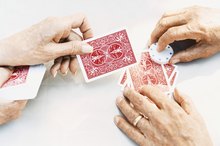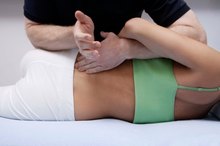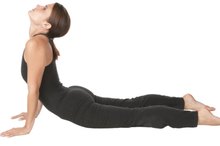How to Put a Dislocated Shoulder Back Into Place
The shoulder is a ball-and-socket joint that allows you to move your arms up, down, forward, backward and in and out. According to the American Academy of Orthopedic Surgeons, this flexibility in movement makes the shoulder prone to dislocations 1. Subluxations refer to partial dislocations in which the humerus (upper arm bone) is partially misaligned with the glenoid (socket). Complete shoulder dislocations refer to complete misalignment of the humerus from the glenoid. Symptoms of shoulder dislocation include swelling, bruising and weakness. There are specific steps to put a dislocated shoulder back into place.
If you are experiencing serious medical symptoms, seek emergency treatment immediately.
Wash your hands with soap and water and dry them well.
Symptoms of Forearm Tendinitis
Learn More
Swab the person's arm with an alcohol swab and have a medical professional inject 30 mg of Ketorolac. This is a type of pain medication.
Ask the person to relax and let his muscles remain loose. Inform him that you will perform maneuvers on his shoulder and let the him know you will stop if there is any pain.
Exercises for Stroke Paralysis on One Side
Learn More
Bend the affected side's elbow to 90 degrees. Grip the the elbow with both hands and apply a traction away from the individual.
Take one hand off the elbow and place it on the forearm. Slowly externally rotate the elbow and stop if the individual feels pain. Continue to maintain traction on the elbow with your other hand. Allow the patient to relax and repeat step 4.
Listen for a popping sound and feel the shoulder. You will feel the ball of the humerus back in its socket (glenoid). If this method does not work, you can try manipulating the shoulder blade using the scapular manipulation technique.
Scapular Manipulation
Have the person sit up and place the patient's uninjured shoulder against the wall. This will serve to stabilize the patient's body when you maneuver his injured shoulder.
Ask a helper to stand in front of the patient and lift the patient's wrist on the affected side until the arm is horizontal to the floor.
Ask your helper to place the individual's other hand (from the unaffected side) palm-down on the collar bone of the affected side. Have the assistant continue to hold the affected side's arm horizontally and have the helper firmly pull the individual's arm toward her. This serves as a counterbalance.
Place your thumb on the individual's shoulder blade on the affected side. Make sure your thumb is directed over the lowest tip of the shoulder blade and apply firm pressure moving the lower part of the shoulder blade toward the middle of the his back.
Place your other hand on the top portion of the affected shoulder blade and apply pressure for stabilization. Make sure your helper continues to pull the individual's arm toward her.
You should hear a popping sound or see the humerus move back into the glenoid. Once this happens, place the arm in a sling and go to your doctor.
Warnings
Handling a dislocated shoulder is a very fragile and complicated process that should ideally be performed by a medical professional. Ask your doctor before attempting these manuevers at home.
- Have the person sit up and place the patient's uninjured shoulder against the wall.
- Ask a helper to stand in front of the patient and lift the patient's wrist on the affected side until the arm is horizontal to the floor.
Related Articles
References
- American Academy of Orthopedic Surgeons
- Jo MJ, Gardner MJ. Proximal humerus fractures. Curr Rev Musculoskelet Med. 2012;5(3):192-198. doi:10.1007/s12178-012-9130-2
- Schumaier A, Grawe B. Proximal humerus fractures: evaluation and management in the elderly patient. Geriatr Orthop Surg Rehabil. 2018;9:1-11. doi:10.1177/2151458517750516
- Harvard Health Publishing. Collarbone (clavicle) fracture. Updated August 2017.
- Frich LH, Larsen MS. How to deal with a glenoid fracture. EFORT Open Rev. 2017;2(5):151-157. doi:10.1302/2058-5241.2.160082
- Panagiotopoulos AC, Crowther IM. Scapular dyskinesia, the forgotten culprit of shoulder pain and how to rehabilitate. SICOT J. 2019;5:29. doi:10.1051/sicotj/2019029
- Cole PA, Freeman G, Dubin JR. Scapula fractures. Curr Rev Musculoskelet Med. 2013;6(1):79-87. doi:10.1007/s12178-012-9151-x
- Ravikanth R, David M, Sandeep S, et al. Prevalence of concomitant injuries with Hill–Sachs lesion in traumatic shoulder dislocations. J Orthop Allied Sci. 2017;5(2):58. doi:10.4103/joas.joas_27_17
- Johns Hopkins Medicine. Humerus fracture (upper arm fracture).
- Jeray KJ. Acute midshaft clavicular fracture. J Am Acad Orthop Surg. 2007;15(4):239-48.
- Nho SJ, Brophy RH, Barker JU, Cornell CN, Macgillivray JD. Innovations in the management of displaced proximal humerus fractures. J Am Acad Orthop Surg. 2007;15(1):12-26.
Writer Bio
Lisabetta Divita is a physician whose love for writing flourished while she was exposed to all facets of the medical field during her training. Her writings are currently featured in prominent medical magazines and various online publications. She holds a doctorate in medicine, a master's in biomedicine, and a Bachelor of Science in biology from Boston College.








